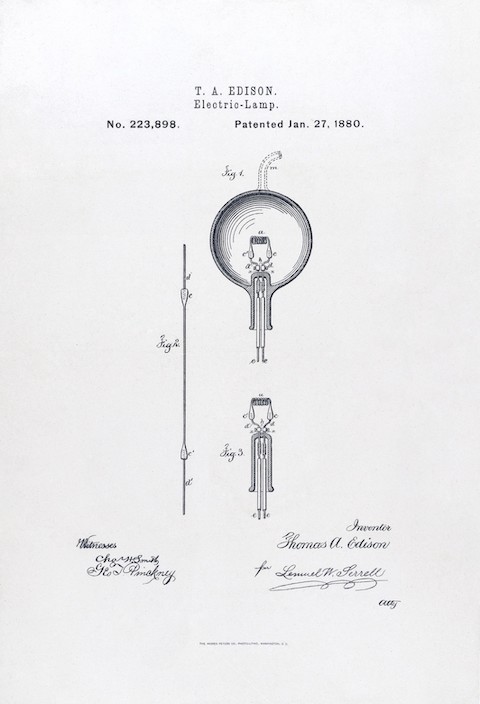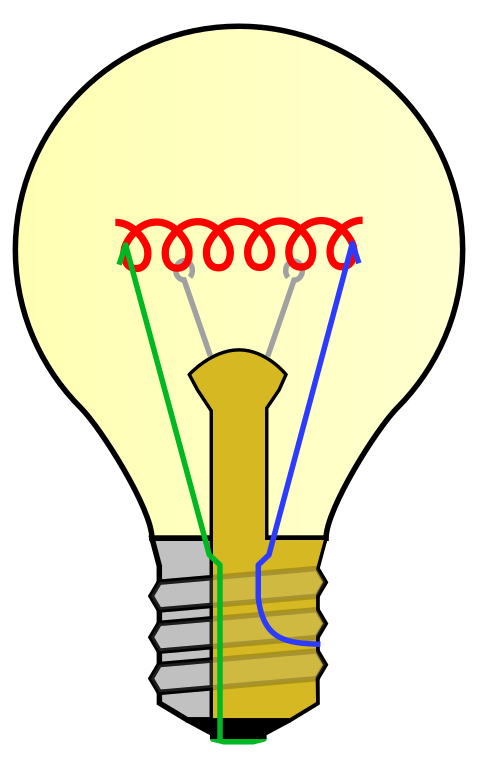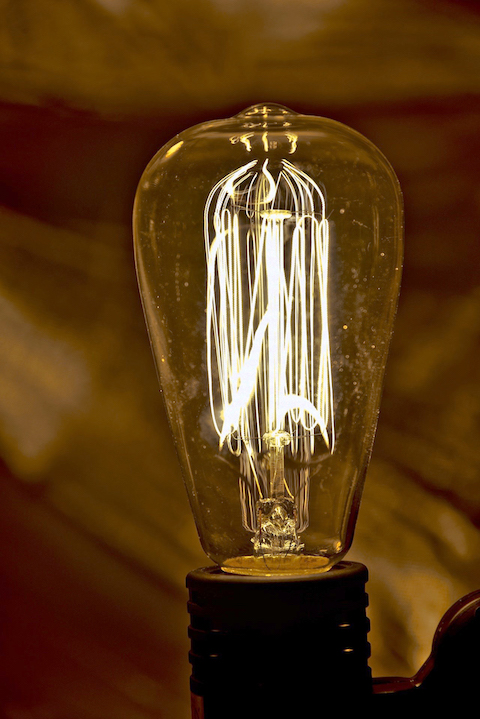
We often think that Thomas Edison invented the light bulb.
While he certainly was the first to make it a commercial success, the invention took almost a century to “come to light.”
The story begins long before household electricity.
In 1800, an Italian scientist named Volta created the first primitive battery. And one of the first things he did was connect copper wire to it, which glowed faintly.
Two years later, a different inventor ran current from a battery through carbon rods to create the first industrial bulb. But it was very bright, short lived, and not suited to household use.
More scientists, over more decades, improved filaments and used a vacuum to remove oxygen, or filled the bulb with nitrogen to extend the filament’s life.
Finally, in the late 1870’s, Edison bought a Canadian patent and formed a light bulb company.
He and his workers tested more than 9,000 filament designs. Their first successful bulbs used carbonized bamboo.
But they ultimately discovered that the rare metal tungsten, with its high melting point and electrical resistance, was the best choice.
At first, Edison’s technology couldn’t make tungsten thin enough. Later advancements wound 6 feet of ultrathin wire down to a 1-inch-long filament. They mounted it on a glass support, and the commercial bulb was born.
This design lasted nearly unchanged for over a century, only now being replaced by more efficient designs which themselves have taken more than 50 years to come to market.
Background
Synopsis: We turn on artificial lighting every day, but not many people know much about the first light bulbs and their place in history. Incandescent lighting took more than 75 years to move from concept to reality, but once refined, the simple design didn’t change for a century. Incandescent lighting was a contributing factor in the development of electrical grids that changed the world. Now, more efficient artificial light sources have taken its place.
- The first light bulbs were a very simple design. At the most basic level, they run on electromagnetic energy: when excited, atoms release electromagnetic energy as photons, which have energy and momentum, but no mass. These photons produce light if they vibrate in the visible spectrum.
- Negatively charged electrons orbit an atom’s nucleus in different levels called orbitals. The most energetic electrons are located in the outermost orbitals.
- When energy is added to an atom by an external source (like an electrical current), some electrons may momentarily jump outward to a higher-energy orbital before being yanked back to their original orbital by the pull of the atom’s nucleus.
- When an electron moves back to its original lower-energy orbital, it releases a photon to expend its excess energy.
- The amount of energy released governs the wavelength of the photon, and if this wavelength is in the visible spectrum, it determines the color of the light emitted.
- All artificial light sources excite atoms in this way to produce light, although the process differs among incandescent filaments, fluorescent gases, and solid-state light-emitting diodes (LEDs).
- Incandescent light bulbs were the first light bulbs to be designed.
- In modern light bulbs, two metal contacts are attached by stiff wires to a thin metal filament supported by a glass mount.
- When electrical current is applied, electrons run through the filament from contact to contact, exciting atoms and producing photons.
- When excited, most metal ions typically release infrared photons until they are heated up to very high temperatures—around 4000°F (2200°C)—which is when they produce light photons in the visible range.
- This is why incandescent light bulbs get so hot—only about 10% of the energy produced is light, with the rest being heat energy.
- The thinner a conductor, the more it heats up. Tungsten wire is used for its abnormally high melting point.
- In a typical 60-watt bulb, ultrathin filaments of tungsten wire (1/100 of an inch, or 0.25 mm thick) start out around 6 ft (2 m) long and are wound into a coil less than 1 in (2.5 cm) long.
- An inert gas like argon fills the bulb to exclude oxygen and prevent combustion. Early bulbs relied on vacuum pumps, but evaporation of the tungsten atoms caused dark deposits to develop on the glass and limited the life of the filaments. Inert argon atoms help to corral the tungsten atoms, keeping them in the filament longer.
- The idea of incandescent light bulbs started taking shape around 1800.

- Prior to electricity, humans relied on fire to light the night.
- Fireplaces, torches, candles, and oil lamps provided light.
- While fire was very accessible, it was also dangerous and produced low-quality light as well as undesirable byproducts like smoke, greasy wicks, and sooty residue.
- By the late 1700s, scientists knew about electricity but had not yet figured out how to turn it into light.
- It took several inventors more than 75 years for the idea of the light bulb to become a reality because supporting technologies had yet to be developed. Their invention wasn’t a “light bulb moment.”
- In 1800, Italian physicist Alessandro Volta used alternating discs of copper and zinc interlayered with salt-soaked cardboard to create a source of electricity called a voltaic pile—the predecessor of modern batteries. Electricity flowed when he connected the ends of a copper wire loop to the voltaic pile, causing the wire to glow faintly. The “volt” was named after him.
- In 1802, Cornish chemist Humphry Davy used Volta’s discovery and invented the first electric arc lamp by connecting a voltaic pile to two carbon rods. But this lamp was incredibly bright and burned out quickly, so while it was used in town squares and industrial plants, it wasn’t very practical for domestic use.
- Inventors tweaked Volta’s and Davy’s discoveries for decades, but all the designs became more and more expensive. A commercially viable invention would need to be cost effective.
- Around 1860, English chemist Joseph Swan produced a light bulb that used carbonized paper filaments confined in a vacuum to extend their lifespan. He received a U.K. patent for his invention in 1878.
- In 1874, inventors Henry Woodward and Matthew Evans filed a Canadian patent for an electric lamp made up of carbon rods in a nitrogen-filled cylinder.
- Thomas Edison was an inventor and a businessman who understood how electricity could change the world. He combined the ideas of earlier inventors with his vision of improving the quality of everyday life for the public.
- He knew that if he replaced the filaments in these inventions with a thin filament of a higher-resistance material, less current would be required to illuminate it.
- His lab in Menlo Park, Calif., tested more than 3,000 designs from 1878 to 1880 before receiving a U.S. patent for the electric lamp on Jan. 27, 1880.
- After testing more than 6,000 materials, they found that filaments of carbonized bamboo would burn for up to 1,200 hours, so these were used in the first bulbs produced commercially.
- Edison bought the Canadian patent in 1879 and teamed up with Joseph Swan in 1883 to manufacture light bulbs as the company Edison-Swan.
- Experiments continued, focused on filament material and the atmosphere within the bulb.
- Tungsten was ultimately determined to be the best filament material because of its high electrical resistance and very high melting point, but the technology to create the ultrathin tungsten wire required for the filament didn’t exist until 1910.
- Meanwhile, Edison knew the market for light bulbs and many other modern conveniences would not exist without a reliable source of continuous electricity.
- In December 1880, he founded the Edison Electric Illuminating Company of New York, which built the world’s first electric grid in Manhattan.
- Public demand for electric lighting took off, and many of his competitors joined him in this venture to form General Electric in 1892.
- Within 25 years, electrical lighting had been installed in millions of homes.
- Originally an urban invention because of population density, it took until the 1930’s for electricity to reach rural America. It still doesn’t exist in some remote parts of the world.
- For more than a century, the incandescent light bulb didn’t change much. Then, in 2007 it started being phased out in the U.S. because of its inefficiency compared to newer artificial light sources.
- Cooler gas-filled fluorescent lights evolved around 1938 from the earliest fluorescent neon lights that were first displayed at the Paris Car Show in 1910. Compact fluorescent lights (CFLs) were developed in 1973 using the same concepts twisted into a different shape.
- Higher-efficiency solid-state light-emitting diodes (LEDs) were accidentally discovered in the early 1960’s while engineers were experimenting with glowing semiconductors in an attempt to create a laser. Today, LEDs can be programmed to turn on and off and to emit colors wirelessly using smartphone apps.
- Perhaps somewhat ironically, the vintage “Edison bulb” is now on trend. Edison bulbs are incandescent bulbs that are made to look like the original bulbs developed by Thomas Edison.


